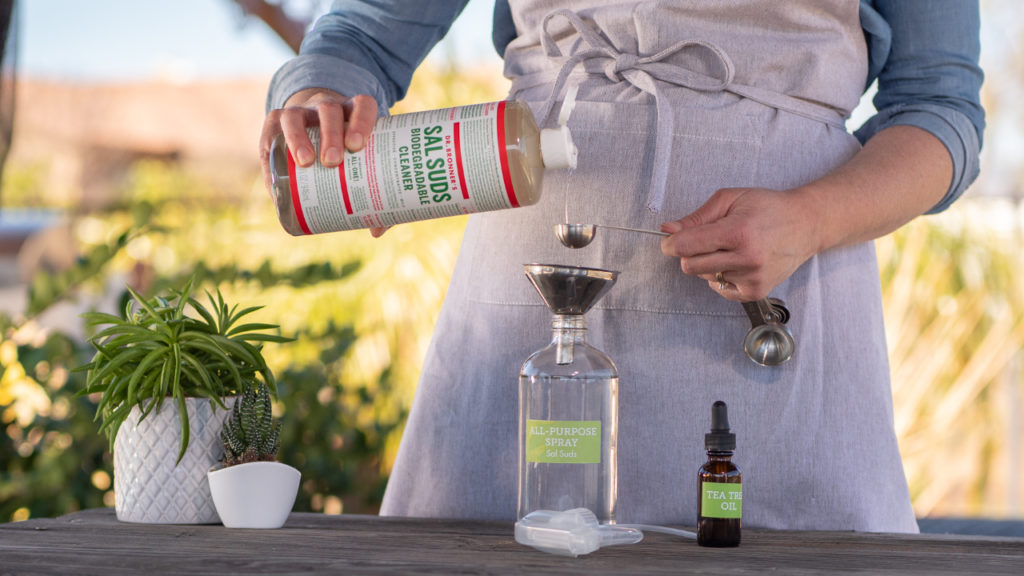
It’s the pillar of the green cleaning cabinet. The Green-It-Yourself (GIY) solution to rule them all. The only answer to, “If you could only have one solution to use for everything, what would it be?” The mixture that began my journey.
The All-Purpose Housecleaning Spray
This spray was my first foray into the realm of green cleaning. I made it right after the life-altering moment of finding that my two-year old son had snuck up behind me while I was cleaning (and I thought he was napping) and had planted the nozzle of 409 firmly in his mouth.
If that moment had not happened, reading that once weekly use of disinfectants increased incidence of Chronic Obstructive Pulmonary Disease (COPD) by 32% would have been the clincher. I was struck by the irony that we clean in order to be healthier, but some of the ways we clean might actually be making us sick.
Happily, I had on hand Karen Logan’s excellent book Clean House, Clean Planet, my first green cleaning guide. Although my grandfather taught me much about the many purposes of diluted Castile Soap, it was Karen who first clued me in to the wonders of putting it in a spray bottle.
This All-Purpose Spray cleans as well as any ready-made, store-bought solution. It is a streak-free cleaner for every surface, takes the place of many other cleaners thereby reducing clutter in my cabinet, and because it dilutes a concentrated cleaner with water, it’s a whole lot cheaper.
What you don’t get with the All-Purpose Cleaning Spray
- Volatile organic compounds (VOCs) with their harmful fumes
- Problematic residues on surfaces
- Fragrances shown to increase incidence of asthma and migraines
- Carcinogenic formaldehyde (Yes, really. It’s common. Read the link.)
All this GIY spray does is clean.
Housecleaning: All-Purpose Cleaning Spray with Dr. Bronner’s Castile Soap or Sal Suds Biodegradable Cleaner
- 1 qt. (1 L) water*
- ¼ c. (60 mL) Dr. Bronner’s Castile Soap (any scent)
OR**
- 1 Tbsp. (15 mL) Sal Suds Biodegradable Cleaner
- 20 drops tea tree essential oil (optional)**
Fill the spray bottle with the water. Add the Castile Soap or Sal Suds and the tea tree essential oil, if desired. Swirl gently to mix. Spray surfaces and wipe with a damp cloth. Alternately, spray a damp cloth and wipe surfaces.
*What Kind of Water: Tap water works fine. However, if your tap water is hard – which means it has a high mineral content, usually calcium and magnesium – the Castile Soap will cause a cloudy precipitate to settle on the bottom of the spray bottle. This is perfectly fine and does not mean the solution is contaminated or won’t work. But if this bothers you, use distilled or Reverse Osmosis purified water. Sal Suds, as detergent, rather than a true soap, does not react with hard water.
**Which to use: Castile and Sal Suds are very interchangeable, but to see the few times I make sure to use one over the other, check out my post Sal Suds or Castile Soap – Which to Use.
***Why Tea Tree Essential Oil: Tea tree essential oil has antimicrobial properties and gives this solution an extra antimicrobial punch. Most times, I don’t add it because I am very confident in the cleaning power of soap and detergent (see below). However, especially if you are having trouble letting go of a conventional cleaner, go ahead and add it for reassurance.
What it cleans
This spray cleans nearly everything I regularly clean. To specify, this means kitchen counters (quartzite and granite), bathroom counters & shower surround (tile), all manner of stone, toilets, painted surfaces, wood tables and cabinets, stainless steel appliances & sink, nickel doorknobs & faucets, ceramic sinks & tubs, carpet (spot cleaning), glass on the microwave & oven doors, leather (not suede) furniture, microsuede, fiberglass, plastic acrylic, outdoor furniture, upholstery, car interiors, pet bowls, baby gear. Even the plastic of the pinball machine in my foyer.
But it’s not just good for cleaning surfaces. There are other key uses for this spray.
Ant spray
When made with the Castile Soap, this spray also eliminates ants and other insects, and removes their scent trails so their compatriots can’t follow. A more diluted version of this spray (1 Tbsp. of Castile Soap) makes a good pest spray for plants, as well. The lesser dilution ensures the soap does not burn the leaves (though spot testing is always wise). With either concentration, it only works when it contacts the pests wet. Its residue is not effective.
Scouring
Spray a surface and then sprinkle on some baking soda and you have an excellent scouring combination. This makes a stainless steel sink shine and cuts through soap scum.
Customization
The further beauty here is in all the options. We are very drawn to scents, and often the biggest hurdle to adopting green cleaning methods is the change in scents. It just doesn’t smell the same. This is true, and often it is in these very smells that we find the most widespread health hazards. But all is not lost. You can add your favorite essential oils to this spray to make it fit your preference, whether it’s your mood, the season, or your dinner. Start with 10 drops and increase as desired.
Whole room top-to-bottom
Picture the contrast: Person A cleans their bathroom with five products and then their kitchen with five different products. Person B uses just one for everything. Think of the elegance, the simplicity of one bottle in hand. No juggling bottles and digging through cabinets and swapping products. Just one cleaner the whole way around.
It’s so carefree, is it really a chore? Ok, so I exaggerate – I’d still rather read than clean, but you get my drift. Finding and using just one bottle makes it a whole lot easier and less hasselsome.
Why this works
The more I’ve studied soap and come to understand how it works, the more I rely on it, and the less I bother with the additional 20 drops of tea tree essential oil because I’m convinced of the power of soap alone. I was further confirmed in this stance by the Center for Disease Control’s (CDC) recommendations, during the height of the Covid pandemic, that:
Cleaning with a household cleaner that contains soap or detergent reduces the amount of germs on surfaces and decreases risk of infection from surfaces. In most situations, cleaning alone removes most virus particles on surfaces. Disinfection to reduce transmission of COVID-19 at home is likely not needed unless someone in your home is sick or if someone who is positive for COVID-19 has been in your home within the last 24 hours.
Soap and detergent – which are part of a category called surfactants – work by removing material from surfaces. They are more like street sweepers, bouncers, erasers. They make things go away. They do not kill as their primary mode of efficacy. Surfactants work by enclosing each bit of debris within a sphere of molecules. This sphere is called a micelle. Once the contaminants are enclosed inside these spheres, water can whisk them away. This whole micellar formation process is the justification for all the soap use instructions you’ve heard:
- 20 seconds (to give the soap molecules time to arrange themselves)
- Vigorous scrubbing (to help the soap molecules wiggle into position)
- Rinse thoroughly (so that water carries away the micelles)
This micelle action means that neither soap nor detergents are primarily antibacterial or disinfectants.
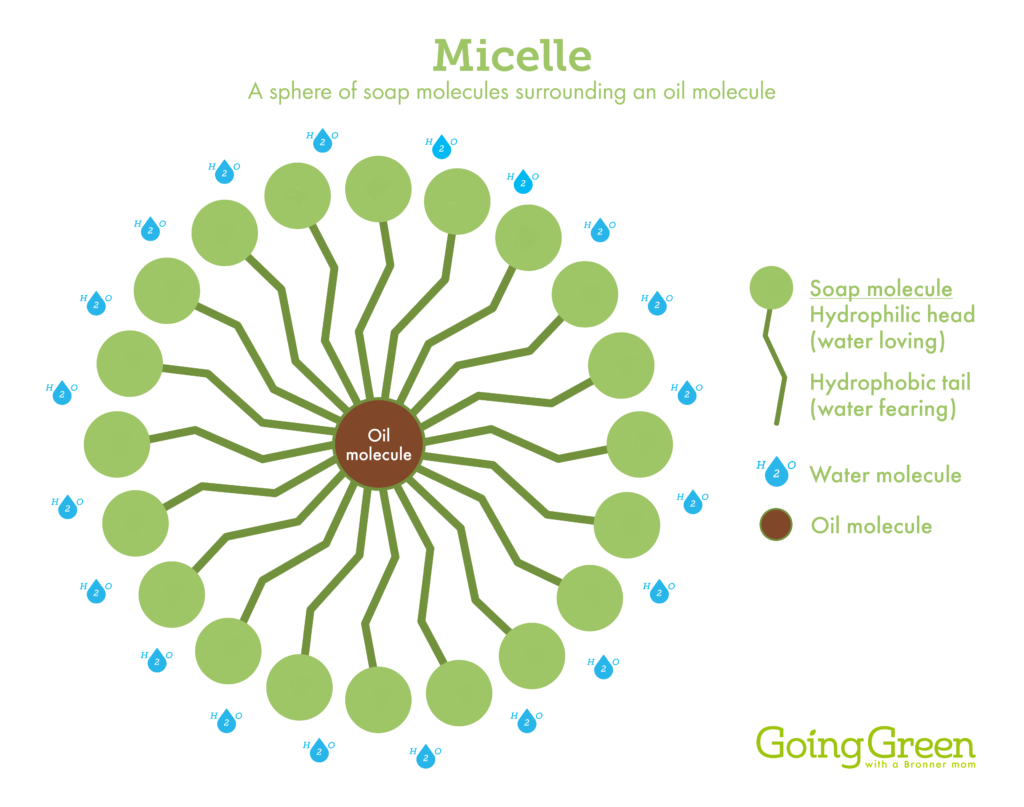
Why then is there such confidence in soaps and detergents? Wouldn’t it be safer just to use disinfectants to ensure germs are gone?
The reverse is actually true. We use soaps and detergents because they are safer. First off, soaps impact everything. Disinfectants are targeted, and may work against some or even many microbes, but not all. Secondly, soaps and detergents remove germs as well as dirt, grease, and grime. Disinfectants, so far as they work, only kill germs but do not remove the dead germs or anything else. Lastly, the harmful side effects of disinfectants outweigh their benefits in daily household usage. Disinfectants proclaim their own danger on their labels via their warning labels that tell you to use gloves, good ventilation, and inform of all manner of harmful effects in case of skin contact or ingestion – everything from subdermal burns to the fatality of the unborn. The risk of misuse of disinfectants, resulting in poisoning, is far far higher than any chance of harm with soap. They are not necessary in daily household use.
I recently discovered to my joy that an empty Dr. Bronner’s quart bottle fits most sprayer attachments. If that’s not handy, purchase a sturdy spray bottle at a home improvement store. Mix up your first batch of All-Purpose Cleaning Spray. Your surfaces, your wallet, and your health will thank you.
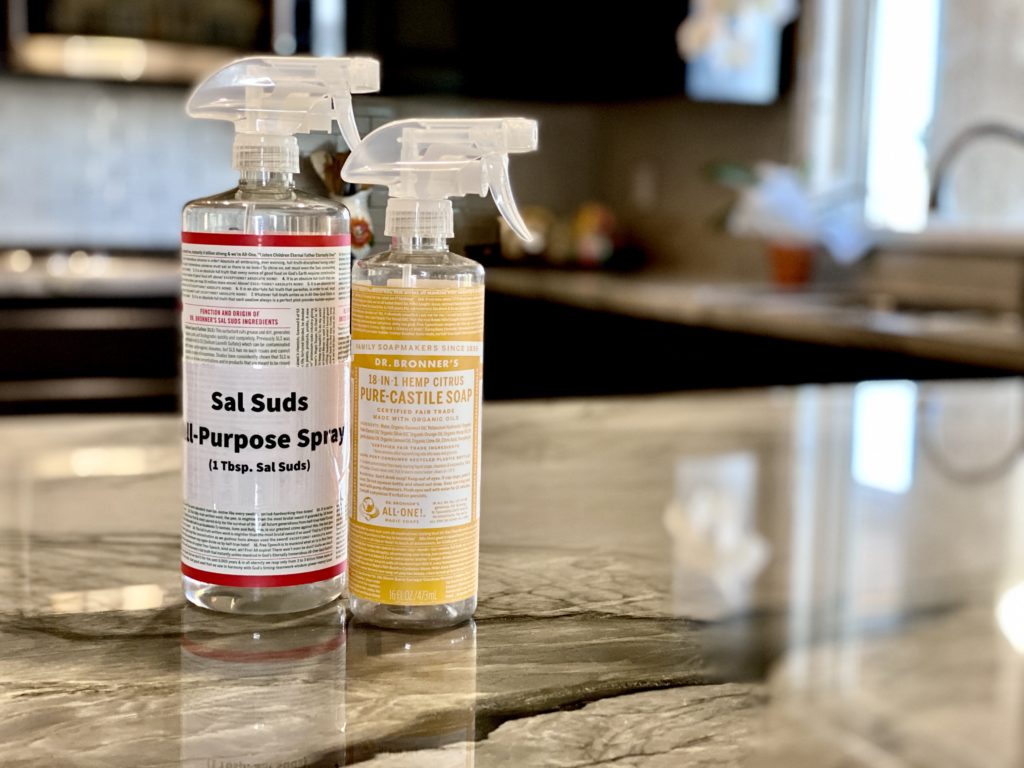
Further reading
Sal Suds cleaner shows >60% biodegradation after 28 days per ISO 14593
This recipe and many more are in my book, Soap & Soul: A Practical Guide to Minding Your Home, Your Body, and Your Spirit with Dr. Bronner’s Magic Soaps, available now in hardback on DrBronner.com or at your favorite bookseller, and as an eBook and audiobook (read by me!) from wherever you download or listen.





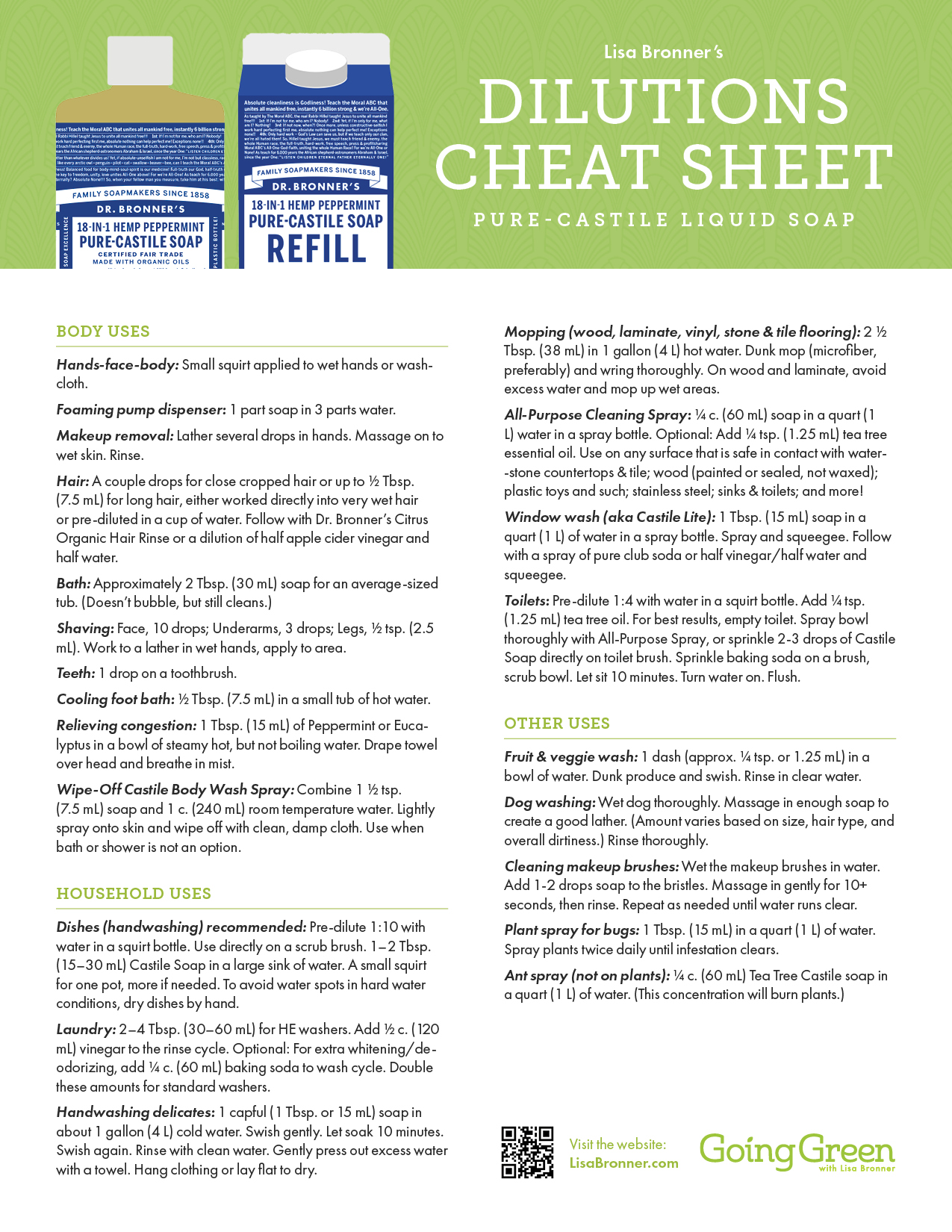
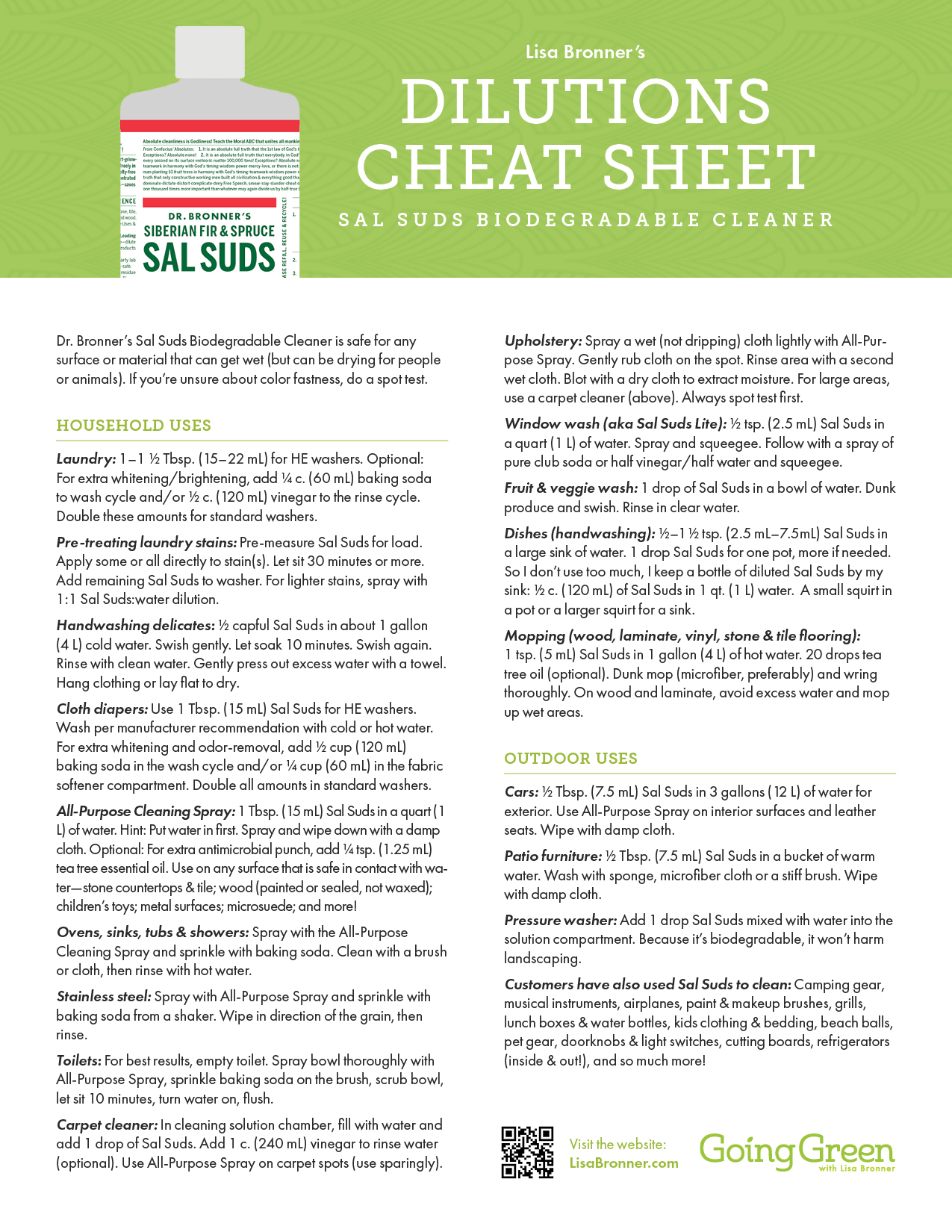
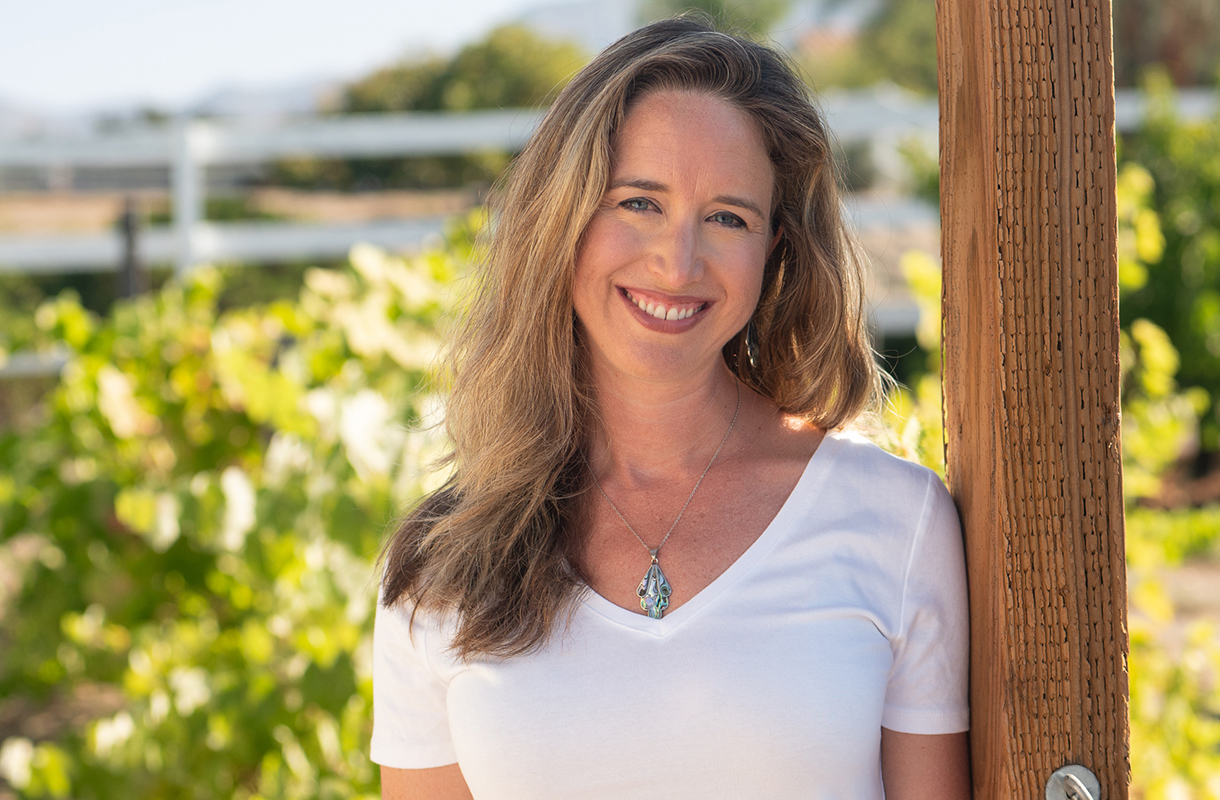

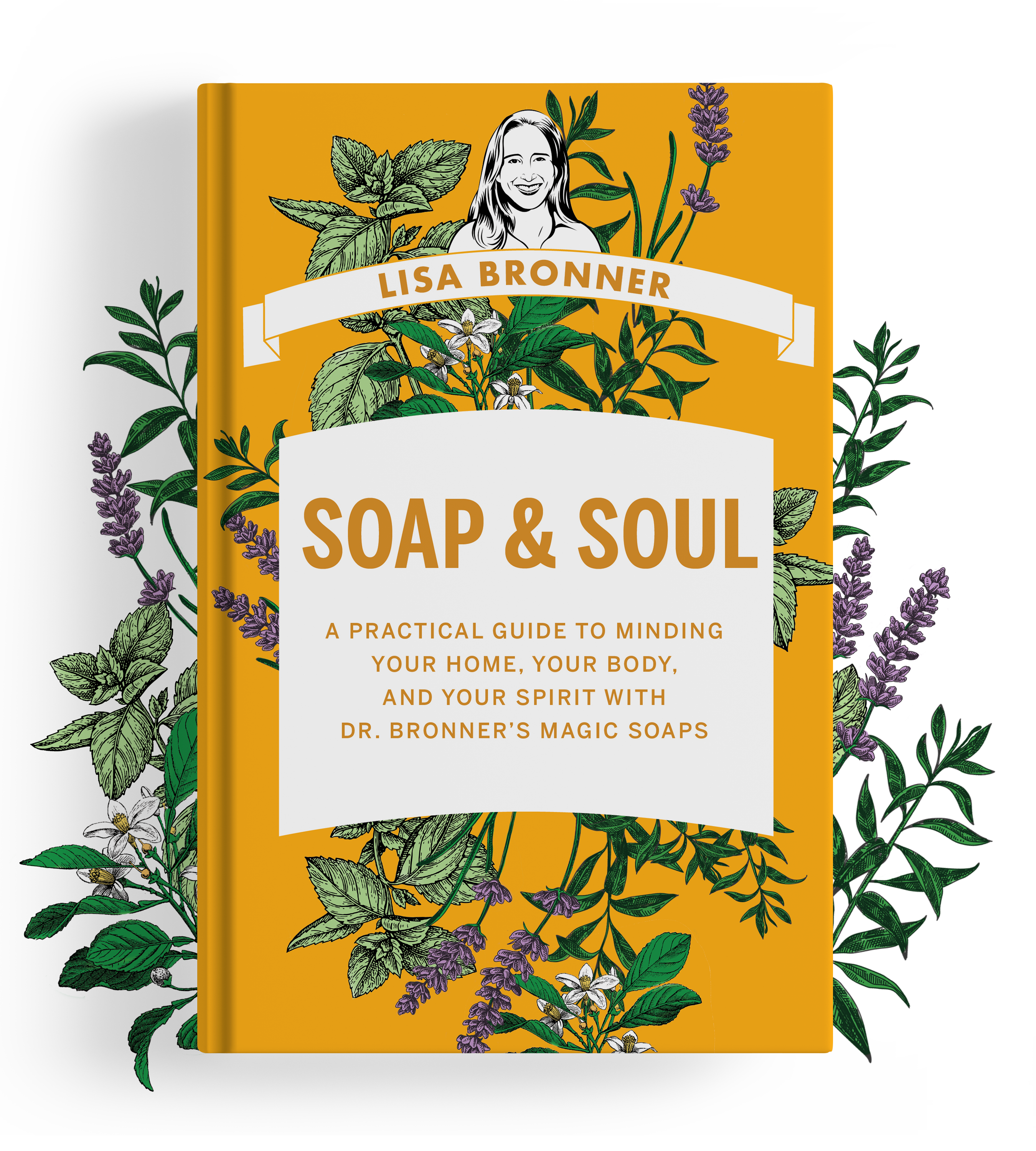
What ratio would you suggest for a degreaser (16oz bottle)? Sometimes the all-purpose ratio does not quite get it after cooking and there is a lot of splatter. This would primarily be used on a stainless stovetop, tile backsplash and quartz countertop. Thanks!
Hi Brandy- You can certainly increase the amount of either Castile Soap or Sal Suds in your All-Purpose Spray solution. You may need to do an extra swipe or two with a damp cloth to remove any soap. When soap is left behind on surfaces it attracts more dirt and grime.
I want to know, does the all purpose spray need to be stored in the fridge or can it be stored room temperature? Does it need a preservative in order to store it at room temperature?
Hi Megan- I have found that the Sal Suds All-Purpose Spray lasts at least a month stored in my cleaning cabinet – probably longer but I run out of it. If it is smelling “off” to you, then dump and remake. If you go through it rather slowly, make smaller batches so it doesn’t sit around. There is no benefit to storing it in the fridge.
Lisa, if one added the tea tree oil, would that help it be preserved longer if you prefer a larger batch at room temp (I hate mixing things so prefer to do it in bulk).
Hi Vi- Unfortunately, tea tree oil does not have the ability to preserve a solution. Making the solution with distilled water will get the longest shelf life out of them.
Hi Lisa!
Reading your posts puts me at such ease. I am switching to nontoxic products as I begin thinking about pregnancy and I am wondering if Sals Suds is safe to use while pregnant? I have heard mixed things about certain ingredients while being pregnant, so any insight or experience you have would be helpful. Thank you!
Hi Anne – I’m so glad my posts have been helpful. Sal Suds is perfectly fine to use while pregnant. I used it through my three pregnancies, and while that’s hardly a statistically relevant sampling, there are several factors that make it a safe option. One is the lack of volatile organic compounds, which means you will not be breathing any fumes that would enter your body and impact your baby’s development. Second is the lack of residues so there is nothing left on surfaces to contaminate them or impact sensitive skin. It is a non-toxic, highly effective cleaner that is great for cleaning all sorts of baby messes that will come once the baby arrives! I am happy to speak specifically to any ingredients you have questions about.
I really appreciate the science lesson on how soap works and the Micelle illustration. I wanted to also see the CDC Covid related information but the “recommendations” link shows a 404 error and the other link goes to more general Covid data. Can you update the links to the specific info, please?
Thanks very much
Hi Diane – Thanks for flagging this! I’ve updated the link, which goes to this site: https://www.cdc.gov/hygiene/cleaning/cleaning-your-home.html.
Can you use Sal suds in the dishwasher, if so how would you ( or not) dilute it.
Hi Jenny- While Sal Suds is excellent at handwashing dishes, we do not recommend it in the the dishwasher. Sal Suds produces copious bubbles while dishwashers require a low-suds product.
Hi Lisa,
I know that so many people write to you I’m sure, and I’m hoping you get a chance to get to my question! I’m just getting over Covid, live alone with my dog, and today is cleaning day! The first time around with Covid, I did not use Dr. Bronner’s to clean with, however, now that I’m **back on the stuff, that’s what I want to do. In the above article, you mentioned cleaning with dr. Bronner’s all purpose spray, and that the CDC says soap and water is fine, but if I’m understanding, if someone has Covid and you’re cleaning for that, something stronger is needed. Do you have recommendations for that?
** I don’t want to leave here without seeing that I’ve been using DR Bronnner’s castille and sal suds for years! I had stopped for a while- was on and off -with the exception of using Sal suds on floors for many years but for the last year or so, I’m back on Castile soap for all purpose as well!
Thank you so much for all that you do, and I really look forward and hope that I’ll hear from you!
Kind Regards,
Tara Lee
Hi Tara – I’m glad you reached out and hope you are feeling much better. Thank you for your long time support and use of our products. When disinfecting is needed, I’ve been guided by the EPA’s Safer Cleaners list, and choose to use either alcohol between 60%-90% spray surface and let air dry – or hydrogen Peroxide, if bought at the standard pharmacy concentration of 3%, diluted with water at a ratio of 1:5 – let sit for 1 minute. Alcohol smells worse but hydrogen peroxide can bleach some surfaces, so spot test before deciding which to use first. Disinfectants are only effective when used for the length of time recommended on their labels, so you will have to read and follow that carefully.
I am looking for your soap to give my small Chiweenie Dog a bath in. What one do you recommend
Hi Kathleen – Oh my, what a cutie. I have a special place in my heart for dachsunds and their relations. Any of the Castile soaps would make a great soap for your pup. I would be inclined to use one the milder ones like Lavender or Almond, but if the Eucalyptus and Peppermint make a lovely combo as well. Check out this video of me and my labrador Tucker: https://www.lisabronner.com/dog-washing-with-dr-bronners-soap/
Hello Lisa, thanks so much for researching all of this cleaning info, i’ve followed your info for years!
Is it ok and beneficial to also add a bit of baking soda to the All Purpose Sal Suds Cleaner? If yes, approximately how much baking soda should be added to the 1 Quart recipe?
Hi Daniela- Thanks for being a long-time follower! Baking soda is a great natural deodorizer and scour-er. I’ve not tried it, but I’d think the baking soda would clog the sprayer of your bottle. It doesn’t dissolve in water like sugar or salt, for example. A great things to do though, is to spray your surface, sprinkle a bit of baking soda on to the area, wipe and then clean with a damp rag. This works especially well on more durable surfaces such as sinks, tubs, and showers.
Hello!
This information is great. I’m new to green cleaning and have a procedure question.
If soap doesn’t kill but takes away, aren’t any germs I’m wiping off the surface now on the rag I’m using to wipe with? For example, if I’m cleaning the sink in the bathroom in the manner you’ve described, do I then want to use a new clean rag to clean the countertop, or then the toilet seat, etc., so I’m not just transferring any germs from one place to another?
Thank you for your help!
Hi Terrie – Welcome! I’m glad this is helpful. Yes, I switch out my rags regularly to ensure optimal cleaning. I have a sack of microfiber cleaning cloths that I use throughout the house. I might use the same cloth on the kitchen counters (unless there might be raw egg on them or such), but then I’d get a new one for the bathroom counter, for the tub and tile, etc. Then I wash all my rags at the end of the day.
Hi Lisa,
When my 20 year old was around 6 we used the Orange castile soap to brush our teeth. I never told him it was soap and he never complained. He loved it! I don’t brush my teeth with it anymore as I can’t get over the “soap” idea. I have begun using the soaps for all my cleaning purposes and I am so very grateful. I am using the Sal Suds for my laundry and don’t have any complaints. Thank you!
I’m so glad, Shelley!
Is it safe to use tea tree oil on soft stone surfaces such as marble or granite?
Hi Courtney – I’m not sure if you mean in this spray or pure on their own. In this spray, it is safe to use tea tree essential oil on all stones. Oils on their own should not sit on stone as they can seep into the pores and discolor it.
Hi, I’m confused about the rinsing aspect. If I’m cleaning my counter I usually spray and then wipe with a paper towel. Are you saying to do that, and then wipe it again with a damp cloth? Or just eliminate the paper towel altogether? Just spray and then wipe with a damp cloth?
Hi Miriah – Just spray and wipe with a damp cloth. The dampness of the cloth is key for adhering to the soap molecules in the spray, and one step of wiping with a damp cloth is sufficient. Let me know if that cleared things up.
Can you add rubbing alcohol or something to the spray so it’s not so watery?
Hi Miriah – No, there is nothing simple that would thicken the solution, and thicker solutions might have difficulty going through the spray apparatus.
Thank you
Hi Lisa,
My child has sensitive skin and eczema. I would like to ask if adding tea tree essential oil into the spray cause any problem on his skin? Thank you.
Hi Tim – For this spray which is meant to be used on household surfaces, adding tea tree essential oil should not impact your son. However, the tea tree essential oil is optional. If you want to keep the solution milder, you can leave that out.
Hi Lisa,
Reading through the benefits on the sal-suds and adding tea tree oil, is this good enough and effective as disinfecting? I usually spray diluted rubbing alcohol on the counter or into the sink if I use raw food. I am hoping the sal-suds spray would be just as good for this purpose.
Thank you.
Tiffany
Hi Tiffany- I use the All-Purpose Spray for cleaning up after raw meats. Sal Suds on its own is effective, and I don’t normally add the Tea Tree oil myself. Soaps or detergents, including Sal Suds and Castile Soap, clean by removing. They remove germs, dirt, oils, and other debris from surfaces. Here’s my deep dive into how soap works https://www.lisabronner.com/how-soap-works/. Disinfectants clean by killing. They are biocides. Unless someone is sick, I do not regularly disinfect my surfaces. This is per the CDC’s recommendation (https://www.cdc.gov/coronavirus/2019-ncov/prevent-getting-sick/disinfecting-your-home.html) as unnecessary disinfecting can reduce the efficacy of disinfectants and unnecessarily expose us to more intense chemicals. When disinfecting is called for, I spray with alcohol and let air dry.
I found an old bottle of Castile soap bottle. Not sure how old it is. What is the shelf life of Dr. Bronner Castile soap?
It looks darker than my new bottle.
Can I still use the old one for cleaning?
Hi Julia- Our soaps have a guaranteed shelf life of 3 years. After this time, the strength of the essential oils may fade, lessening the scent, but the soap is still effective. The manufacture date is etched on the packaging, typically just below the label. The first four numbers there are the Julian date. The first two digits refer to the year while the next three digits refer to the day of the year out of 365 total days. So, if the first five digits of a lot code are “20165,” the product was manufactured in 2020 on the 165th day of that year (June 13). You can also search online for a Julian date calendar for the specific year your bottle was manufactured in. If the soap does not smell bad, then it is good to go. I’ve heard many stories of people finding old bottles and using them just fine. The difference in color between the two bottles could be due to age, but also our soaps vary in color from batch to batch since we use organic oils that fluctuate slightly in color themselves.
Hi! Which tea tree you recommend? Or how can I know which brand is best?
Hi Elsa- Look for pure essential tea tree oil. If it doesn’t say “pure essential”, then it is diluted in some other carrier oil, like olive oil. I buy mine online through Frontier Natural Products, but there are many other options out there.
Do I need to add a preservative to this since it’s mostly water?
How long can this mixture stay good without a preservative?
Thank you!!
Hi Tracey – You could add an antioxidant like vitamin E (open a capsule and squeeze it in) to preserve it, but I usually don’t. If you use it within a month or two, it will be fine. Its shelf life depends on a bunch of factors such as the type of water going in and the temperature of storage.
Thank you Lisa! I didn’t sterilize the spray bottles I purchased, but I do use distilled water. It is stored at room temperature. Do you think that’s ok?
Thank you so much!!
Hi Tracey – All that sounds good!
Lisa, This is extremely helpful I have severe contact dermatitis and Dr. Bronner’s baby soap (liquid and bar) are two of the very few items that are safe for me to use. If I have the foaming hand soap formulation 1:3, do I need to make a different formulation to hand wash dishes at 1:10? I am wondering if I can use the foaming soap for both. Thank you
Hi Beth- I’m glad to hear our Unscented soaps are a help to you! You can use the foaming pump dilution for dishes. Just use a small dollop since it’s more concentrated. It’s okay to further dilute the foaming pump to 1:4 or even 1:5 for hands for a less concentrated dilution.
I always like to mix things by ratio. Makes it so much easier. Your all-purpose spray would be 1:66. That might be a little difficult so my next favorite way is by percentage. Using this ratio it would be 1.5%. Now it really gets easy. Weigh your water in grams and add 1.5% grams SS to that weight. Then you can mix any quantity with ease.
Excellent! Thanks for breaking that down.
I have used Sal Suds for my laundry for years. It was recommended at a gray water lecture since my gray water runs into my avocado tree. I buy it from you by the gallon and will mix up a quart today and start cleaning!
What would you suggest for my bamboo floors….no rinsing.
Thank you always for your interesting information.
Hi Vitina- I have bamboo flooring and I use the Sal Suds mopping solution, which is 1/2 Tbsp. Sal Suds in 3 gallons of water. Works excellently. Take care to mop up puddles and excess water.
Was wondering if these sprays are safe on food contact surfaces or is a rinse required? I’ve been using the Castile soap in different scents to match the season….almond for Autumn, rose for Spring, citrus for Summer and peppermint for Winter. Restful lavender always to dust and clean the bedrooms. Love it! Thanks so much!
Hi Sheri- Rotating scents to match the season – so fun! At this dilution, rinsing off the All-Purpose Spray is as simple as wiping surfaces with a damp cloth. No need for an extra rinse.
With tea tree being an anti fungal,is that also the same with the lavender essential oils in your castile soap
Hi Melissa- I’m not aware of any research showing that lavender is microbial in the same way as tea tree essential oil. A few drops of tea tree essential oil can be added to any of our Castile Soaps though.
Hi Lisa,
I am from overseas and living in the states, new to the product. My spray bottle isn’t that big, so for All-Purpose Housecleaning Spray with Dr. Bronner’s Castile Soap, 1. how much Castile Soap, should I put in for every 500 ml of distilled water, and how much essential oil? 2. Can I replace tea tree oil with other essential oil? Thank you!
Hi Peilun- That’s about half of what I recommend in the post, so use 2 Tbsp. of Castile Soap and 10 drops of essential oils. Tea tree essential oil has natural microbial properties and will give your All-Purpose Spray an extra boost. Check out my Castile Soap Cheat Sheet for more uses & dilutions! https://www.lisabronner.com/dilutions-cheat-sheet-for-dr-bronners-castile-soap/
How long after concocting this does it last in your cabinet for use?
Hi Samantha- The typical shelf life is about a month. If it is smelling “off” to you, then dump and remake. If you go through it rather slowly, make smaller batches so it doesn’t sit around.
Hi Lisa,
I am very curious about your all cleaning spray recipe, especially now that I am pregnant and need to avoid toxic cleaners. How does this recipe fair against surfaces that may have been exposed to salmonella or other heavy duty germs ?
Hi Natalie – Congratulations! I also remember how pregnancy was such a motivator to look more deeply into everything around me. Soap is an excellent eliminator of all manner of germs and grime. It does not kill as would a pesticide/antibacterial product, but rather it bonds to everything and carries it away. The Castile leaves no residues and produces no harmful fumes. For a deeper dive into soap, check out my recent article on “How Soap Works.”
Is it still worth adding tea tree essential oil to the all purpose cleaner if you already have tea tree fragranced soap? Or is the amount of tea tree for fragrance a lot less than 20 drops?
Hi Arnold – Unless I feel a mess is incredibly icky, I don’t add the extra Tea Tree essential oil, especially if I’m already using the Tea Tree Castile Soap. The soap itself is doing the cleaning, and I am very confident in it. There is a 2% concentration of Tea Tree essential oil in the Tea Tree Castile Soap, which equals about 1.2 mL in the recommended 1/4 cup of Soap/quart. This is more than 20 drops.
Question- Can i use this on my floor? Its that lvp type fake wood flooring made from vinyl and its plank. I want to have some kind of shine and not a dull look and I don’t want to ruin the flooring.
Hi Donna- Absolutely! Sal Suds and Castile Soap both work well on your type of flooring. Add either 1/2 Tbsp. Sal Suds or 1/2 cup Castile Soap to approximately 3 gallons of hot water. On wood and laminate, avoid pooling water and mop up wet areas.
I have that same book and use the recipe “Alice’s Wonder Spray” which includes Sal Suds, but also requires Borax dissolved in vinegar and hot water. I’m not understanding how this recipe can leave that out, since doing so might leave a residue problem.
Hi Laurie- Then you know what an excellent resource Clean House, Clean Planet is! This All-Purpose Spray is based off the author’s “Merlin’s Magic” recipe. I choose not to use Borax because it irritates the skin and lungs and is toxic if ingested. (It’s not like drain cleaner or anything, but since soap and Sal Suds work and are not toxic at all, I don’t bother with Borax at all.) There is no residue from Sal Suds if properly diluted and wiped with a damp cloth.
The download link for the Sals Sud Cheat Sheet PDF is linking to the Castile Soap Cheat Sheet. Could you please fix this? I would like to print both sheets. Thank you!
Hi Shelley- I’m so sorry about that. Our developers are working it. In the meantime, here’s the link to the Sal Suds Cheat Sheet: https://www.lisabronner.com/sal-suds-dilution-cheat-sheet/
Lisa, I’m looking for a product that I can spray on a micro fiber cloth and use for dusting. Do either Sal Suds or Castile Soap (when diluted) make a good all-purpose dusting solution? Are there any surfaces that should be avoided? If so, what would the best dilution ratios be for dusting? Thanks!
Hi Mike- Yes, the All-Purpose Spray made with either Castile Soap or Sal Suds will do the job. The spray works on any surface that can get wet, including painted and sealed surfaces. If you’re unsure, spot test in an inconspicuous area first.
Love these products. Do the sprays require a follow up rinse after using? Thanks!
Hi Suzie- To use, just spray and wipe with a damp cloth. No extra rinsing needed.
Hi! I love the soaps and have been using them for years! However, this is the first time I’ve ever gone onto your website (I don’t know why!), and am loving all the information I’m learning from it! That’s when found out about hard water and its reaction to the soaps and what to do about it (use a vinegar rinse).
My question is, would adding vinegar to the all-purpose spray alter its effectiveness?
Thank you again, for the awesome products!
‘
Hi Shara- Vinegar is great to have in your green cleaning arsenal. But adding it to the All-Purpose Spray will not improve the cleaning efficacy of the Sal Suds. Rather vinegar, as an acid, will impact the pH of the Sal Suds, which is an alkaline, and reduce it’s cleaning power.
All one god faith! The old man was a delight and a treasure. I miss his rhetoric on the label. It was better than church! Thanks for keeping me clean. Steve
Thank you for giving us better options. I have studied the effects of “fragrance” on hormones, etc. and am convinced that we would all be so much better off to eliminate the use of commercial cleaners that contain so many chemicals. The women in my family have history of “hormone imbalance” and migraines caused by this. I am excited to learn more about essential oil combinations and uses for castile soap. I have even been using castile soap as body wash and shampoo. My hair is so much healthier and my skin is more balanced. Also, I am definitely also a huge fan of baking soda as a natural cleanser. Again, thank you.
Great article for information and thanks for book recommendation and recipe
How would the addition of a little vinegar affect the solution?
Hi Cristy- Save your vinegar for other green cleaning duties! Vinegar, as an acid, will impact the pH of the Sal Suds, which is an alkaline and reduce it’s cleaning power. When mixed with Castile Soap, vinegar causes it to unsaponify – that is, break down into a goopy, oily mess (more on that here: https://www.lisabronner.com/a-word-of-caution-about-vinegar-and-castile-soap/). The All-Purpose Sprays work best as-is.
Hi Lisa, Thanks for your excellent Green Cleaning tips! I noticed towards the end of your article it mentioned ***Rinse thoroughly (so that water carries away the micelles) *** . Does that mean every time I wipe down the counters, microwave etc. with a Sal Suds solution I should also rinse them off with clean water? The reason I ask is that we have very hard water, so I was planning to use distilled water in the Sal Suds solution. I think I’d also make a second spray bottle of plain distilled water to rinse and wipe dry. P.S. Lemongrass Essential Oil is a wonderful choice to add to a general all-purpose cleaning solution — it has a fresh & lovely scent — all you need is 5-6 drops. 🙂
Hi Ellie- Oh, I do love the scent of Lemongrass! At this dilution, rinsing off the All-Purpose Spray is as simple as wiping surfaces with a damp cloth. No need for an extra rinse.
Thank you for this article!
Promptly made a bottle of the sal suds all purpose spray. I loved the hack about the spray bottle top fitting the sal suds container. Very happy to have one cleaner to replace the many, especially for cleaning the baby stuff, found that super useful. Many thanks!
Hello! I love your Sal Suds product, but I’ve just discovered it and was wanting to know about all the ways of using it. When I tried to download the dilutions page, what appeared on my screen was the dilution info for the castille soap. Where can I find the dilution page for Sal Suds?
Hi Amy- Thanks for pointing that out! I need to tap our developers to make that fix. Here’s a link to the Sal Suds Cheat Sheet: https://www.lisabronner.com/sal-suds-dilution-cheat-sheet/
Funny, my daughter and I were just talking about liquid fabric softener ( we no longer use and swapped out dryer sheets for wool balls) and how it created a thick waxy build up in our last washer and I mentioned that I started to have a extra hard time trying to breathe when fabric softener was in use and I do have COPD. I would rather use vinegar and natural ingredients when it comes to cleaning for many reasons. I will have to add this “recipe” to my cleaning supplies. Thank you for your many insights!
Hi Lynn- I’m so glad to hear you found this post helpful!
Awesome idea! I don’t have a quart bottle but I do have a 16 oz bottle on hand, so I did some math and now I have a working bottle of magic cleaner. I have some peppermint castile soap, so I added lavender essential oils because I love that combination. I’ve pretty much sprayed every surface in the past 20 minutes!
Hi Leanah- Ha! That’s excellent! Great to know this post was helpful to you.
I suggest that you call the oil soluble “tail” of the long soap molecule “lipophilic” because it is in fact and explains why it adheres to oil and lipid membrane of micro-organisms.
Hi Alex – You are absolutely right. Lipophilic is another way to describe the tail, literally meaning “fat loving.” The tail is both hydrophobic and lipophilic. I love all the Greek!